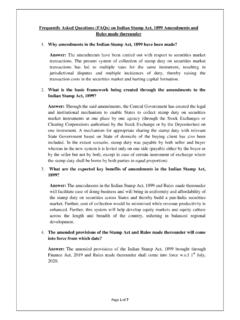Transcription of Report of the Committee to propose specific actions ... - DEA
1 28th February 2019 Report of the Committee to propose specific actions to be taken in relation to Virtual Currencies Department of Economic Affairs, Ministry of Finance New Delhi, India 3 Contents .. 3 1 Overview of Distributed Ledger Technologies 11 The work of the Committee .. 11 Origin of Distributed Ledger Technologies .. 12 Growth and adoption of DLTs .. 14 Trends in market adoption of DLTs .. 15 DLTs as the underlying technology for virtual currencies .. 16 Risks and regulatory challenges .. 17 Recommendations .. 19 2 Virtual Currencies 21 Virtual currencies launched globally .. 21 Virtual currencies as a form of assets: Initial Coin Offerings.
2 22 Virtual currencies as payment systems, legal tender and means of ex- change .. 22 Regulatory concerns around virtual currencies .. 27 Regulatory approaches adopted globally .. 32 The suitability of a ban on cryptocurrencies .. 33 Recommendations of the Committee .. 34 3 Digital currency for India using Distributed Ledger Technologies 37 Review of proposed designs for Central Bank Digital Currency .. 38 CBDC in India: Risks and issues in implementation .. 41 Countries that have adopted CBDCs .. 43 Legal Framework for a proposed Central Bank Digital currency .. 44 Recommendations of the Committee .. 45 4 Distributed Ledger Technologies and potential for financial services 47 Possible use case of DLT for financial services.
3 47 DLT adoption and data localisation .. 52 Recommendations .. 53 5 Summary of Recommendations 55 6 Banning of Cryptocurrency & Regulation of Official Digital Currency Bill, 2019 59 4 A Annexures 79 Annexure-A: Constitution of the Committee .. 80 Annexure-B: Record of discussion of the meeting to study the issues related to Virtual/ Crypto currencies .. 81 Annexure-C: Record note of discussion of the meeting on virtual currency 83 Annexure-D: Record of discussions of the meeting to study the issues related to Virtual Currencies .. 87 Annexure-E: Regulatory treatment of cryptocurrencies in different ju- risdictions .. 94 Annexure-F: Detailed comparison of legal framework with regard to cryptocurrencies.
4 98 5 A high-level Inter-ministerial Committee (IMC) was constituted on 2nd November, 2017 under the Chairmanship of Secretary, DEA to study the issues related to Virtual Currencies and propose specific action to be taken in this matter. The mandate of the Committee included an examination of the policy and legal framework for the regulation of virtual currencies. The subject of virtual currency is complex owing to its unique features and varying degree of understanding in different jurisdictions. The existing global regulatory and legal structures clearly divide the globe into three blocks: I Countries with no legislation or regulation on VCs; I Countries having legislative/regulatory framework on VCs; I Countries that have imposed ban/restrictions on VCs.
5 There is a growing trend of developing regulatory and legal structures around vir- tual currencies throughout the world. The IMC has accordingly examined regulatory developments in different jurisdictions in the course of its work. The Committee studied the domestic and international scenario including the various initiatives taken by other governments and regulators, and analysed reasons impacting its growth in understanding the trajectory of regulation and development in virtual currencies. The task of putting together the key issues, global experiences, challenges faced by industry and policy options thereon, developing the rationale for the final recommendations would not have been possible without the efforts of the members of the Committee and all those who enriched the discussion.
6 The Committee was ably supported by the research work of the Macro/Finance Policy team comprising Aditya Rajput, Anirudh Burman, Ashish Aggarwal, Bhavyaa Sharma, D. Priyadarshini, Jai Vipra, Nelson Chaudhuri, Radhika Pandey, Shivangi Tyagi and Sumant Prashant at the National Institute of Public Finance and Policy. I appreciate and acknowledge their contribution to this Report . February 2019 New Delhi Subhash Chandra Garg ACKNOWLEDGEMENTS ACKNOWLEDGEMENTS The Committee to study issues related to Virtual Currencies was constituted on 2nd November 2017 under the chairmanship of Shri Subhash Chandra Garg, Secretary, Department of Economic Affairs, Ministry of Finance and comprising of Shri Ajay Prakash Sawhney (Secretary, Ministry of Electronics and Information Technology), Shri Ajay Tyagi (Chairman, securities and Exchange Board of India) and Shri Ka- nungo (Deputy Governor, Reserve Bank of India).
7 The mandate of the Committee has been to study various issues pertaining to Virtual Currencies and to propose specific actions that may be taken in relation thereto. Subsequent to the constitution of the Committee , the Hon ble Union Finance Min- ister, in his Budget Speech in 2018 (at paragraph 112), also announced the following, which has further guided the [mandate/approach] of the Committee : Distributed ledger system or the BLOCKCHAIN technology ALLOWS ORGANIZATION of ANY CHAIN of records or TRANSACTIONS without the need of INTERMEDIARIES. The Government does not consider cryptocurrencies LEGAL tender or coin AND will TAKE ALL MEASURES to ELIMINATE use of these CRYPTOASSETS in FINANCING ILLEGITIMATE ACTIVITIES or AS PART of the PAYMENT system.
8 The Government will explore use of BLOCKCHAIN technology PROACTIVELY for ushering in DIGITAL economy. Approach of the Committee Accordingly, the Committee has undertaken a review and analysis of the policy and legal frameworks governing Virtual Currencies across several jurisdictions with a view to derive an understanding of various concerns surrounding Digital Currencies/ Vir- tual Currencies/ Cryptocurrencies and recommend appropriate measures to address such concerns. In doing so, the Committee has sought to understand the international experience of both developed and developing jurisdictions. The Committee has held three Inter-ministerial Committee meetings till date viz.
9 , on 27th November 2017, 22nd February 2018 and on 9th January 2019. Representa- tives of the Ministry of Corporate Affairs, the Central Board of Direct Taxes and MeitY have also participated. Report and Recommendations The Report examines the DLT as the underlying technology for Virtual Currencies/ Cryptocurrencies in Chapter 1 on Overview of Distributed Ledger Technologies. Dis- EXECUTIVE SUMMARY tributed Ledger Technologies allow the recording, sharing and transfer of data or value without the need for a central record keeping as in the case of a traditional ledger. Such records are immutable and non-repudiable. Blockchain is a specific kind of DLT which rose to prominence as the underlying technology for the cryptocurrency, Bitcoin.
10 Internationally, the application of DLT is being explored in the areas of trade fi- nance, mortgage loan applications, digital identity management or KYC requirements, cross-border fund transfers and clearing and settlement systems. However, there are several risks and regulatory challenges. Technologically, scal- ability and transaction speed as also interoperability and integration into existing financial systems remain a challenge. Other key technological risks concern cyber se- curity and data protection. There are also legal and regulatory risks and challenges. The Committee also notes that being at a development stage, several financial sector regulators and standard-setting bodies are exploring its application.




